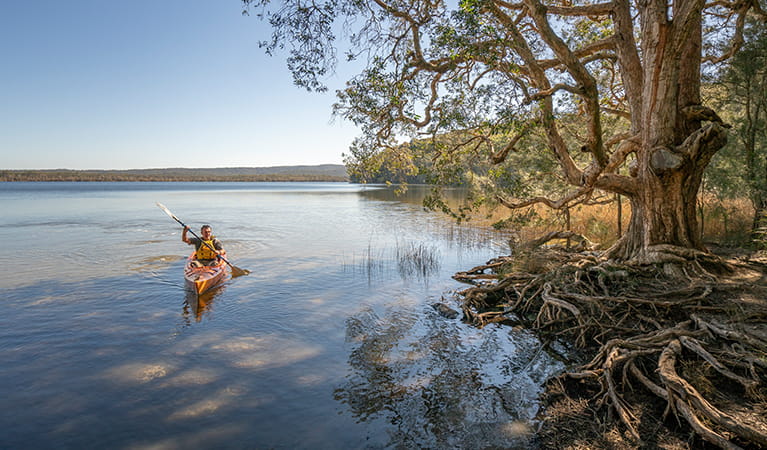Myall Lakes National Park
Overview
Myall Lakes National Park, north of Newcastle offers great walking, kayaking and fishing opportunities. You can camp out or stay in heritage listed accommodation.
Read more about Myall Lakes National Park
Myall Lakes National Park, on the north coast not far from Newcastle, features one of the State’s largest coastal lake systems that offers countless opportunities for canoeing and kayaking, boating and fishing. The park also boasts more than 40kms of beaches that offer some good swimming and surfing spots.
You can visit for a daytrip to enjoy a barbecue or picnic and some walking, but it’s better to come for the weekend or longer to enjoy all that the park has to offer. There are lots of great campgrounds, some large and some small, including campsites for tents, trailers, caravans, motorhomes, and even boats, so you’re bound to find the perfect site to suit your needs. If camping is not your style, you can book in to the heritage listed accommodation at Sugarloaf Point Lighthouse.
Be sure to check out the Grandis; a 76 metre high flooded gum that is one of the tallest trees in the state. You’ll find it in the Grandis picnic area north east of Bulahdelah.
Local alerts
For the latest updates on fires, closures and other alerts in this area, see https://www.nationalparks.nsw.gov.au/visit-a-park/parks/myall-lakes-national-park/local-alerts
Map
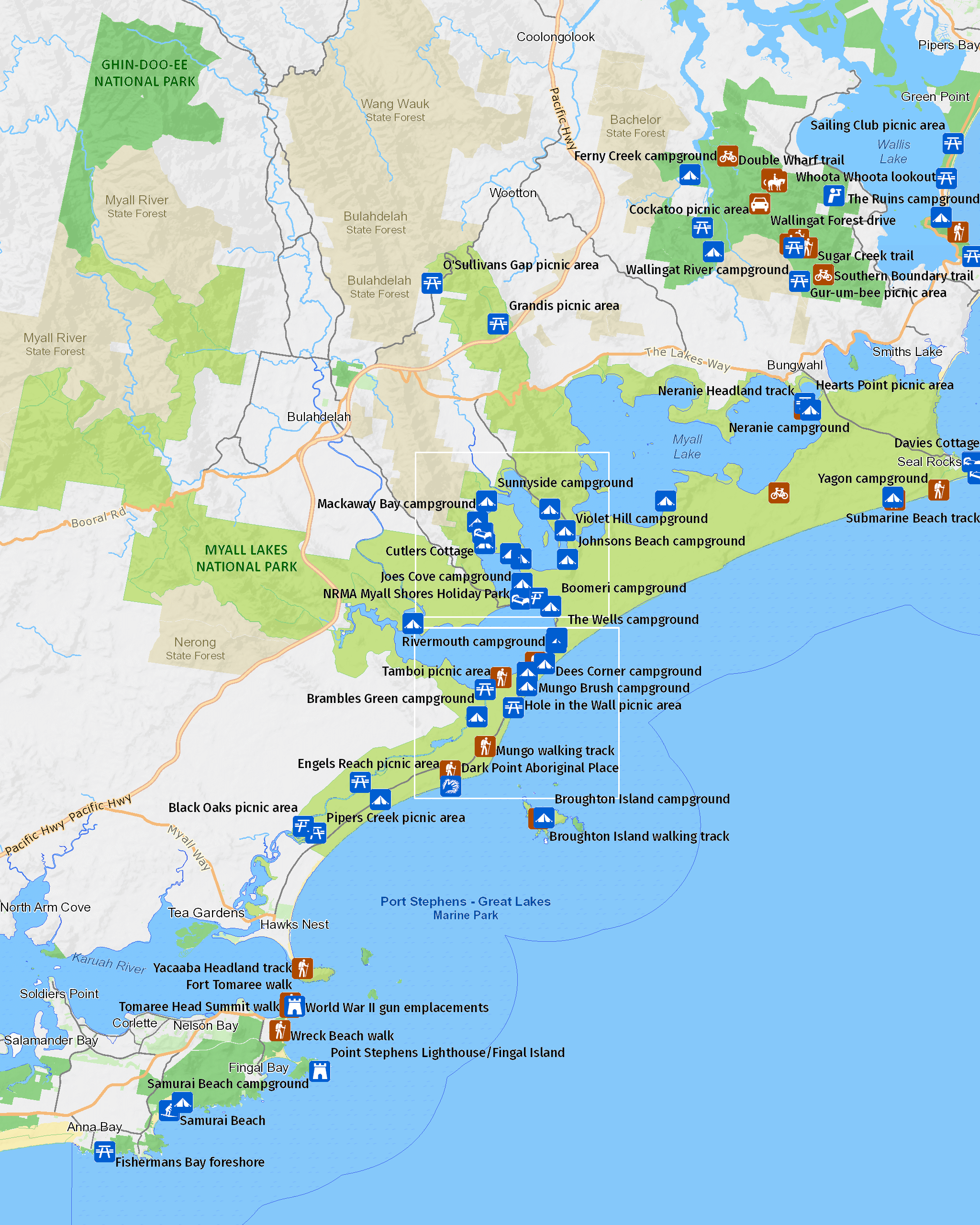
Map
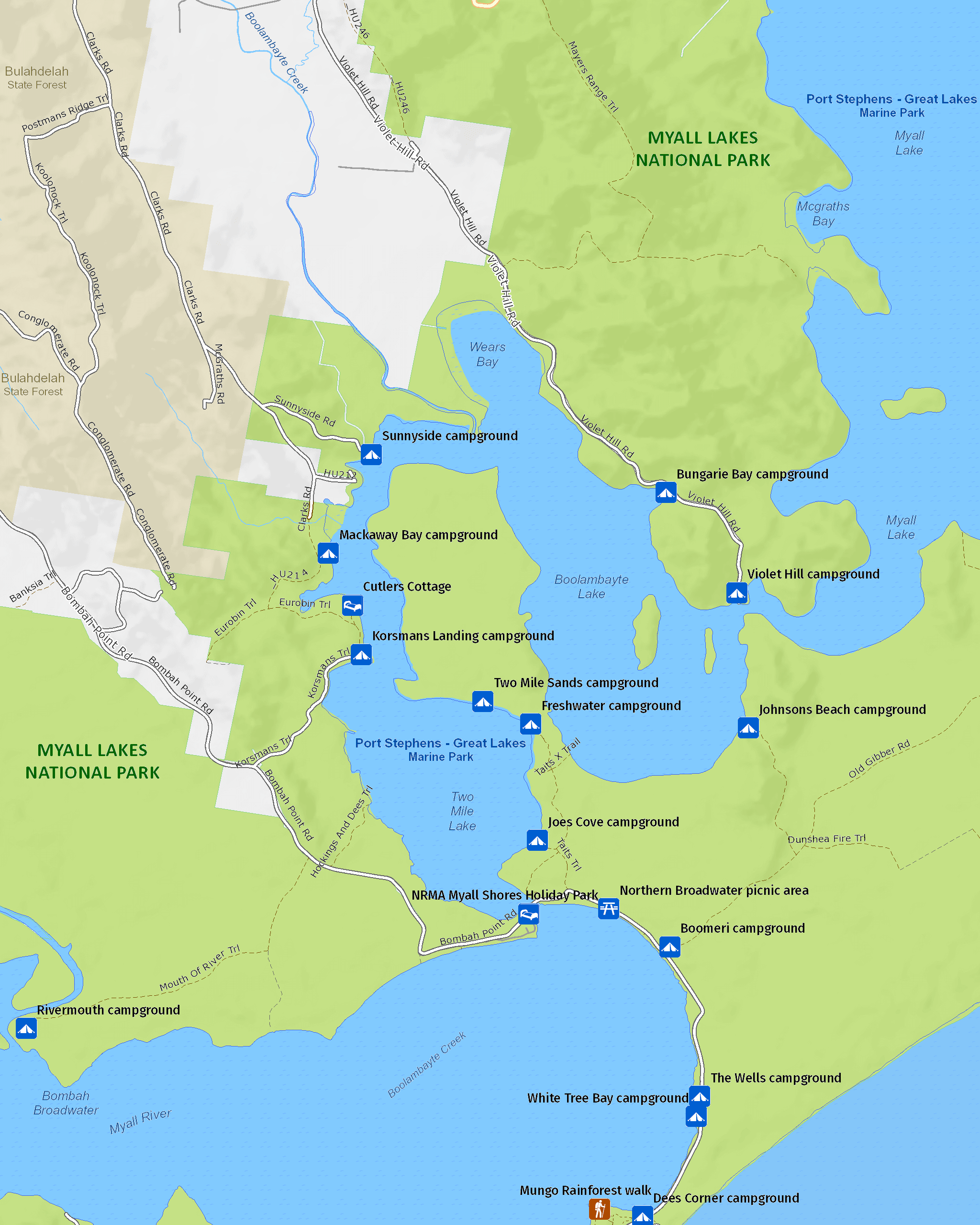
Map
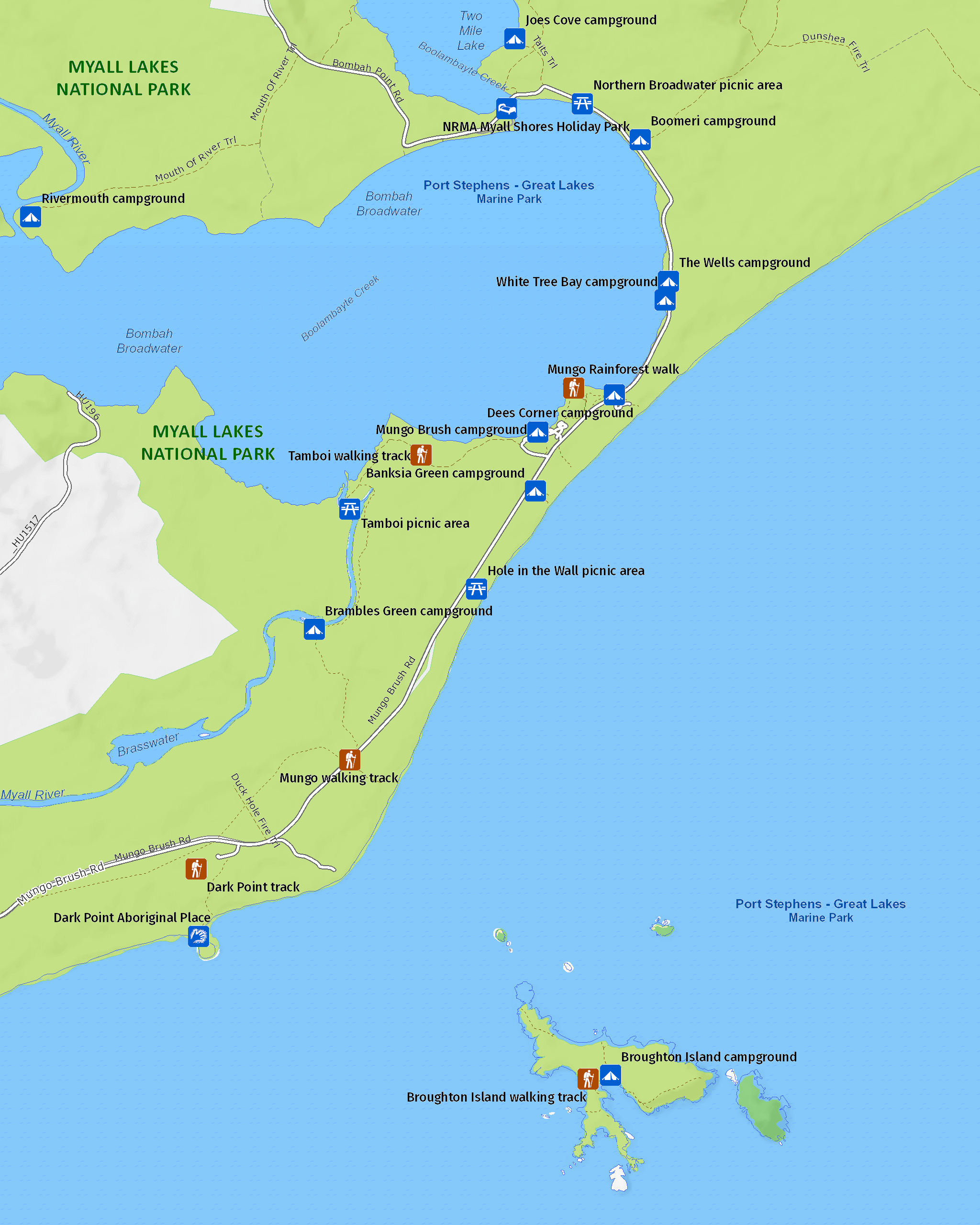
Map legend

Contact
- in the North Coast region
Myall Lakes National Park is always open but may have to close at times due to poor weather or fire danger.
-
Park entry fees:
$8 per vehicle per day.
The park has coin/card operated pay machines at Mungo Brush campground. Day passes are also available from the Manning Great Lakes Area Office, Bulahdelah Visitor Information Centre and the Hawks Nest Newsagency. You can also pay for your visit via the Park’nPay app.
Bombah Point ferry fees may also apply (cash payment only).
Buy annual pass. -
-
Booti Booti Office
02 6591 0300
Contact hours: Monday to Friday, 8.30am to 4.30pm. Closed public holidays. - The Ruins campground, Booti Booti National Park, 4374 The Lakes Way, Booti Booti 2428
-
Email: npws.manninggreatlakes@environment.nsw.gov.au
-
Booti Booti Office
Visitor info
All the practical information you need to know about Myall Lakes National Park.
Getting there and parking
Get driving directions
From the Pacific Highway take:
- Tea Gardens Road to access the Myall River and Bombah Broadwater precincts of the park
- Bombah Point Road to access the Boolambayte and Bombah Broadwater precincts of the park
- Seal Rocks Road to access the Sugarloaf Point to Shelley Beach precinct of the park
There is a vehicle ferry at Bombah Point which provides access across the lake (operates 8am to 6pm daily, fees apply: cash payments only). Under strong winds the ferry may be closed. Contact the park office to check. Ferry fees are as follows:
- $2.50 per pedestrian
- $5.50 per motorbike
- $6.50 per car
- $6.50 caravan, trailer or boat trailer
- $10 per 4 tonne or larger vehicle
Please note: dogs are not permitted in the park which includes the ferry and Mungo Brush Road.
Parking Show more
- Banksia Green campground See on map
- Dark Point Aboriginal Place See on map
- Davies Cottage See on map
- Hearts Point picnic area See on map
- Hole in the Wall picnic area See on map
- Korsmans Landing campground and picnic area See on map
- Neranie campground and picnic area See on map
- Northern Broadwater picnic area See on map
- NRMA Myall Shores Holiday Park See on map
- O'Sullivans Gap picnic area See on map
- The Wells campground See on map
- White Tree Bay campground and picnic area See on map
- Yagon campground See on map
Road quality
- Sealed roads
Vehicle access
- 2WD vehicles
Weather restrictions
- All weather
By bike
Check out the Bicycle information for NSW website for more information.
By public transport
For information about public transport options, visit the NSW Country Transport website.
Best times to visit
There are lots of great things waiting for you in Myall Lakes National Park. Here are some of the highlights.
Autumn
A good time to visit when the weather is a little cooler and the park is less busy.
Spring
Magnificent wildflower displays as they bloom across the heathlands.
Summer
Look for dolphins swimming among the waves.
Winter
Head to Sugarloaf Point to watch for whales on their annual migration.
Weather, temperature and rainfall
Summer temperature
Average
19°C and 27°C
Highest recorded
41.5°C
Winter temperature
Average
10°C and 19°C
Lowest recorded
1.1°C
Rainfall
Wettest month
May
Driest month
November
The area’s highest recorded rainfall in one day
257.8mm
Facilities
Amenities
Toilets Show more
- Banksia Green campground
- Boomeri campground
- Broughton Island campground
- Broughton Island walking tracks
- Bungarie Bay campground
- Cutlers Cottage
- Davies Cottage
- Dees Corner campground
- Freshwater campground
- Grandis picnic area
- Hearts Point picnic area
- Johnsons Beach campground
- Korsmans Landing campground and picnic area
- Mungo Brush campground
- Neranie campground and picnic area
- Northern Broadwater picnic area
- NRMA Myall Shores Holiday Park
- O'Sullivans Gap picnic area
- Rivermouth campground
- Shelly Beach campground
- Stewart and Lloyds campground
- The Wells campground
- Violet Hill campground and picnic area
- White Tree Bay campground and picnic area
- Yagon campground
Picnic tables Show more
- Broughton Island walking tracks
- Grandis picnic area
- Hearts Point picnic area
- Hole in the Wall picnic area
- Mungo Brush campground
- Neranie campground and picnic area
- NRMA Myall Shores Holiday Park
- O'Sullivans Gap picnic area
- Tamboi picnic area
- Violet Hill campground and picnic area
- White Tree Bay campground and picnic area
- Yagon campground
Barbecue facilities Show more
Boat ramp Show more
- Hearts Point picnic area
- Korsmans Landing campground and picnic area
- Mungo Brush campground
- NRMA Myall Shores Holiday Park
- Tamboi picnic area
- Violet Hill campground and picnic area
Cafe/kiosk
Drinking water
Showers
Electric power
Maps and downloads
Fees and passes
Park entry fees:
$8 per vehicle per day.
The park has coin/card operated pay machines at Mungo Brush campground. Day passes are also available from the Manning Great Lakes Area Office, Bulahdelah Visitor Information Centre and the Hawks Nest Newsagency. You can also pay for your visit via the Park’nPay app.
Bombah Point ferry fees may also apply (cash payment only).
- All Parks Pass - For all parks in NSW (including Kosciuszko NP) $190 (1 year) / $335 (2 years)
- Multi Parks Pass - For all parks in NSW (except Kosciuszko) $65 (1 year) / $115 (2 years)
- Country Parks Pass - For all parks in Country NSW (except Kosciuszko) $45 (1 year) / $75 (2 years)
- Single Country Park Pass - For entry to a single park in country NSW (except Kosciuszko). $22 (1 year) / $40 (2 years)
Annual passes and entry fees (https://www.nationalparks.nsw.gov.au/passes-and-fees)
Prohibited
Generators
Generators are prohibited in this park.
Pets
Pets and domestic animals (other than certified assistance animals) are not permitted. Find out which regional parks allow dog walking and see the pets in parks policy for more information.
Smoking
NSW national parks are no smoking areas.
Nearby towns
Hawks Nest (3 km)
Hawks Nest is a small and tranquil seaside town. It's set in majestic surroundings on the northern shore of the Forster Area.
Bulahdelah (13 km)
Buladelah is the gateway to Myall Lakes National Park. It's situated on the Myall River, with a backdrop of soaring, forested hills.
Forster (37 km)
Dominated by water sports Forster is the centre of the Great Lakes area.
Learn more
Myall Lakes National Park is a special place. Here are just some of the reasons why:
Go fish
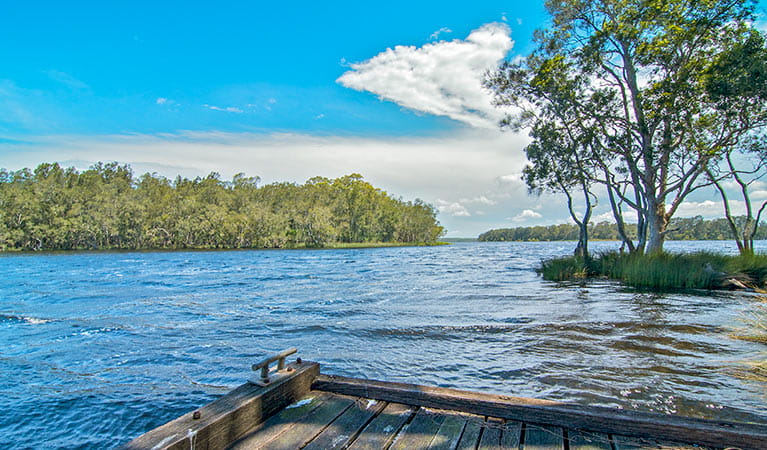
Fishing is a popular activity in Myall Lakes, with catches likely to include bream, whiting, Australian salmon, flathead and mullet. There are lots of great places in the park to throw in a line, like the beaches, lakes or rivers. Try fishing from your boat or for a relaxing day on the water you could try a spot of kayak fishing. At Myall Lakes you can also go camping, boating, swimming and canoeing. And when you’ve tried all of those, you can explore the park on foot, by 4WD or bike, stopping for a spot of bird watching or to enjoy a picnic or barbecue lunch along the way. Whatever your interests, there is bound to be something that takes your fancy.
- Mining Road to Old Gibber Road cycling trail Mining Road to Old Gibber Road cycling trail is an easy bike ride within Myall Lakes National Park. You can complete the ride in one day or take your tent to camp overnight.
- Mungo Rainforest walk Enjoy a short and easy rainforest walk with the birds in Myall Lakes National Park, not far from Buladelah. Afterwards, you can enjoy a picnic or barbecue at Mungo Brush.
Ancient connections
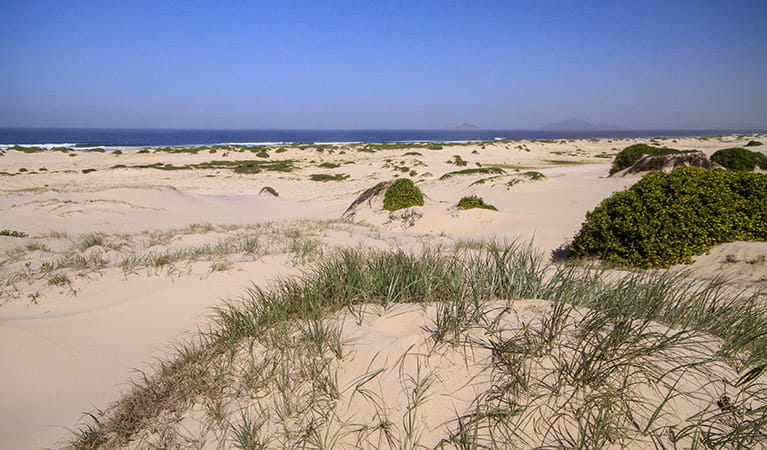
Myall Lakes National Park is part of the Country of the Worimi Aboriginal people, who used the area's natural resources, like freshwater lakes, the ocean and native flora and fauna to live a traditional fisher-hunter-gatherer lifestyle. Much evidence of their long connection with this Country can be seen today throughout the middens in the park. The landscape of Myall Lakes includes important spiritual sites that are an important part of the identity of local Aboriginal people. Make sure you visit Dark Point Aboriginal Place while you're at visiting the park. This rocky headland has been of significance to Worimi people for at least 4000 years. The clans or nuras (family groups) within the Worimi people would gather together here for ceremonies and feasts.
- Dark Point Aboriginal Place Dark Point Aboriginal Place, in southern Myall Lakes National Park, is a culturally significant site for the Worimi people with scenic coastal views across to Broughton Island.
- Mungo walking track Mungo walking track offers a variety of Aboriginal and historic sites, diverse vegetation, and mountain biking in Myall Lakes National Park, near Hawks Nest.
Internationally recognised wetlands
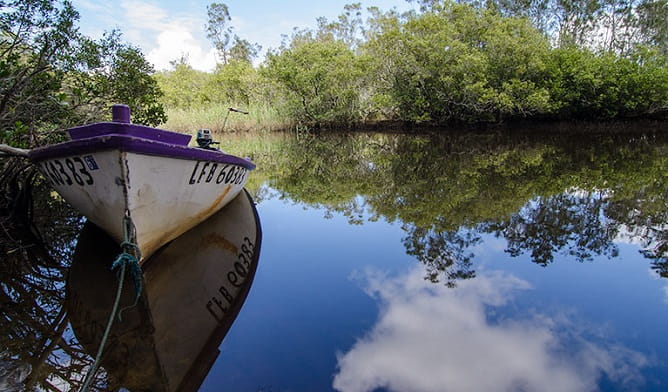
Since 1999, this internationally recognised wetlands site, has been listed under the Ramsar Convention due to its diverse mosaic of near-natural wetlands, within a relatively unmodified coastal lake system. There are 18 different wetland types with extensive interconnected lake and river systems within the forested wetlands and swamps that fringe the waterways, rocky and sandy shores, and offshore islands off the coastline. This wetland site houses a complex variety of habitats with rich biodiversity, including threatened species and migratory birds protected under international agreements. The Myall Lakes wetlands also have a high cultural and social value as they occur within the traditional lands of the Worimi Aboriginal people, where the varied wetlands, environments and abundant resources provided an ideal living environment. Evidence of this traditional occupation exists across the landscape, including the Dark Point Aboriginal Place.
Plants and animals protected in this park
Animals
-

White-bellied sea eagle (Haliaeetus leucogaster)
White-bellied sea eagles can be easily identified by their white tail and dark grey wings. These raptors are often spotted cruising the coastal breezes throughout Australia, and make for some scenic bird watching. Powerful Australian birds of prey, they are known to mate for life, and return each year to the same nest to breed.
-
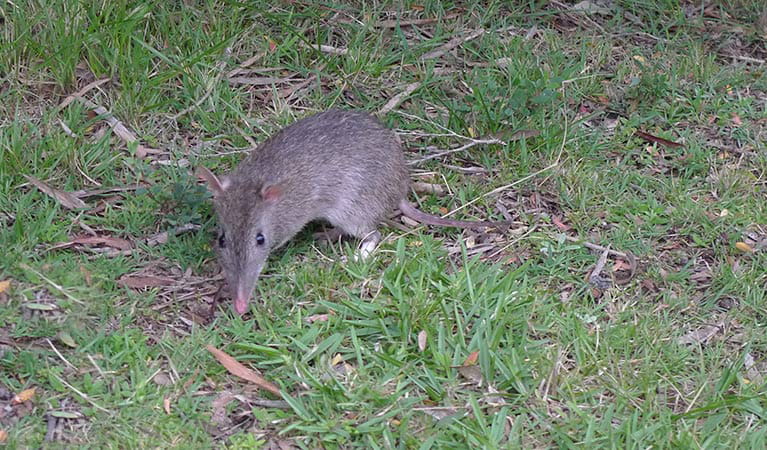
Long-nosed bandicoot (Perameles nasuta)
A nocturnal marsupial and one of the smaller Australian native animals, the long-nosed bandicoot is found across eastern Australia. Populations in the Sydney region have dwindled since European settlement, leaving only endangered colonies in inner western Sydney and at North Head, near Manly. The long-nosed bandicoot has grey-brown fur and a pointed snout which it uses to forage for worms and insects.
-
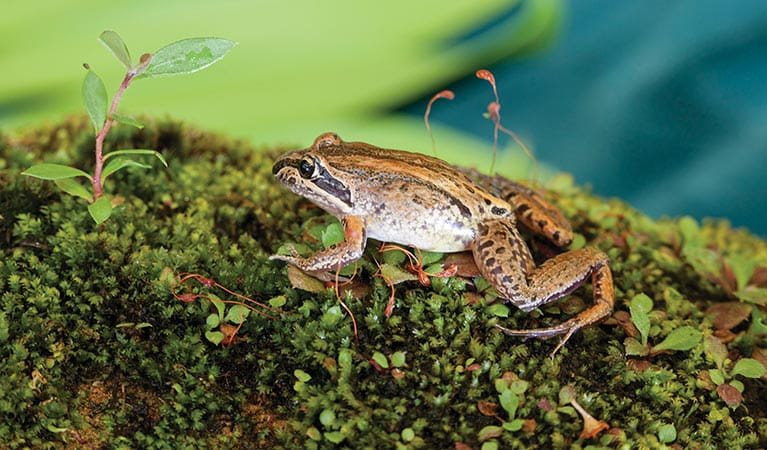
Brown-striped frog (Lymnastes peronii)
One of the most common frogs found in Australia, the ground-dwelling brown-striped frog lives in ponds, dams and swamps along the east coast. Also known as the striped marsh frog, this amphibian grows to 6.5cm across and has a distinctive ‘tok’ call that can be heard all year round.
-
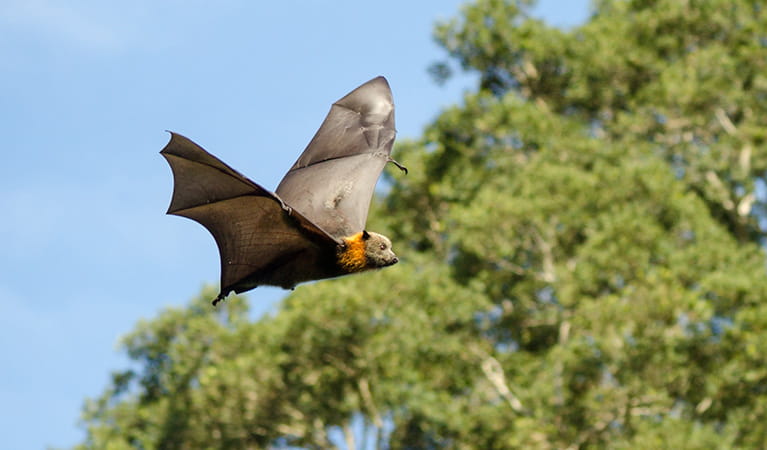
Grey-headed flying-fox (Pteropus poliocephalus)
The grey-headed flying fox is Australia's largest native bat, with a wingspan up to 1m. This threatened species travels up and down south-eastern Australia and plays a vital role in pollinating plants and spreading seeds in our native forests.
Plants
-
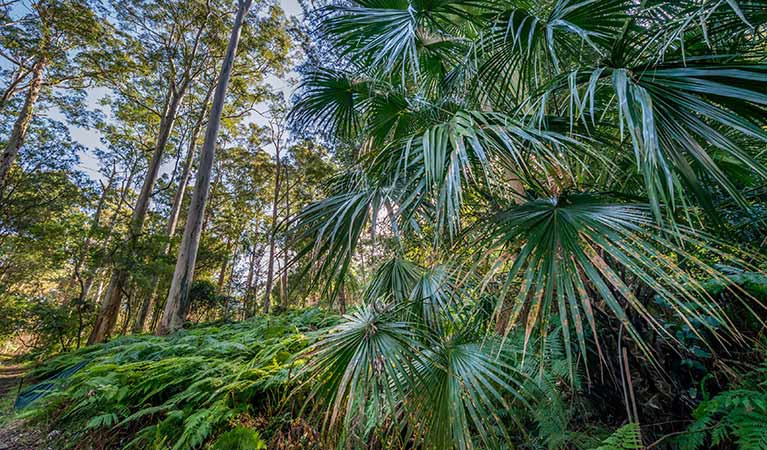
Cabbage palm (Livistona australis)
With glossy green leaves spanning 3-4m in length and a trunk reaching a height of up to 30m, the cabbage tree palm, or fan palm, is one of the tallest Australian native plants. Thriving in rainforest margins along the east coast of NSW, in summer this giant palm produces striking spikes of cream flowers which resemble cabbages.
-
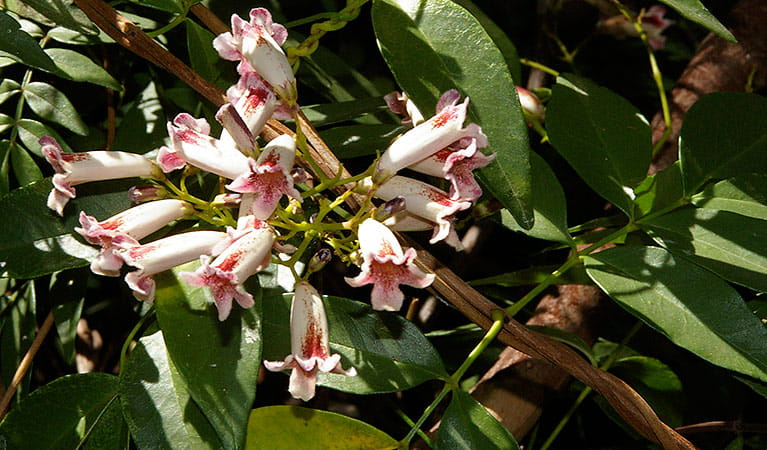
Wonga wonga vine (Pandorea pandorana)
The wonga wonga vine is a widespread vigorous climber usually found along eastern Australia. A variation of the plant occurs in the central desert, where it resembles a sprawling shrub. One of the more common Australian native plants, the wonga wonga vine produces bell-shaped white or yellow flowers in the spring, followed by a large oblong-shaped seed pod.
Environments in this park
Education resources (1)
What we're doing
Myall Lakes National Park has management strategies in place to protect and conserve the values of this park. Visit the OEH website for detailed park and fire management documents. Here is just some of the work we’re doing to conserve these values:
Understanding landscapes and geology
An important feature of the Myall Lakes system are the extensive areas of wetlands it contains. These remarkable natural areas help to protect the water quality of the lakes, while also providing vital habitat for a range of plants and animals including native and migratory waterbirds. Migratory waterbirds rely on wetlands in the southern hemisphere as a refuge from the freezing winter conditions of their northern hemisphere breeding grounds. Protecting park landscapes, educating the community and displaying current signage are priorities for NPWS, and projects are ongoing within this park to preserve the future of the wetlands.
Preserving biodiversity
Myall Lakes National Park monitors and supports the plants and animals within its borders. Consequently, efforts to minimise the impact of key threats are ongoing and include considered pest management, weed control programs including bitou bush and protection of important migratory bird habitat. NPWS is committed to plant and animal conservation, and protects threatened, vulnerable and endangered species within all NSW national parks.
Managing weeds, pest animals and other threats
Pests and weeds have a significant impact on the ecosystems within Myall Lakes. NPWS carries out risk assessments around the park as well as pest reduction of wild dogs to protect biodiversity in this park.
Historic heritage in our parks and reserves
Myall Lakes National Park features significant heritage sites and areas including Sugarloaf Point Lighthouse and Cutlers Cottage that require concerted maintenance and, when required, conservation and upgrading efforts. NPWS continues to monitor the conditions of these sites to ensure that the heritage of this park is preserved for years to come.
Developing visitor facilities and experiences
NPWS is dedicated to ensuring visitors have positive experiences in NSW national parks. In keeping with this, tourist accommodation, campgrounds, picnic areas and other visitor facilities in Myall Lakes National Park are serviced and maintained to a high standard. Internal processes and systems are also regularly reviewed to streamline the visitor experience.
Conserving our Aboriginal culture
The Worimi Aboriginal people maintain a strong, enduring connection with Myall Lakes National Park. NPWS works in partnership with the Karuah and Forster Aboriginal Land Councils in the co-management of park projects, and strives to ensure cultural sites within the park are appropriately recognised, supported and conserved.
Managing fire
NSW is one of the most bushfire prone areas in the world as a result of our climate, weather systems, vegetation and the rugged terrain. NPWS is committed to maintaining natural and cultural heritage values and minimising the likelihood and impact of bushfires via a strategic program of fire research, fire planning, hazard reduction, highly trained rapid response firefighting crews and community alerts.

